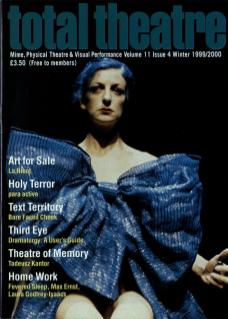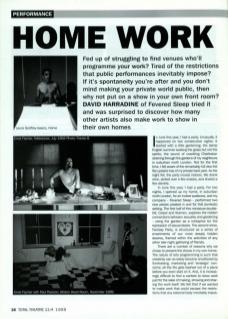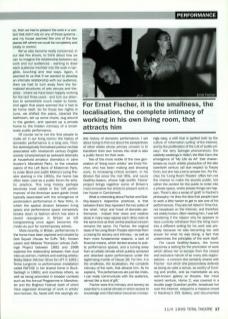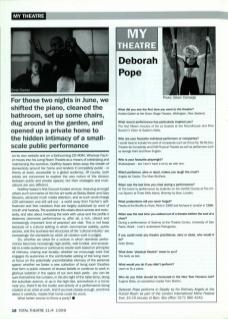In June this year, I had a party. Unusually, it happened on two consecutive nights. It started with a little gardening: the damp English summer soaking the grass but not the spirits; the sound of crackling Charleston straining through the gardens of my neighbours in suburban north London. Not for the first time, I felt aware of the remarkably full view the flat upstairs has of my private back yard. As the night fell, the party moved indoors. We drank wine, picked over a few snacks, and shared a few secrets.
In June this year, I had a party. For two nights, I opened up my home, in suburban north London, for an invited audience, and my company – Fevered Sleep – performed two new pieces created in and for this domestic setting. The first half of this miniature double-bill, Carpel and Stamen, explores the hidden connections between sexuality and gardening – using the garden as a metaphor for the repression of sexual desire. The second show, Fantasy Party, is structured as a series of enactments of our most deeply hidden desires, framed within the activities of any other late-night gathering of friends.
There are a number of reasons why we chose to present the shows in my own home. The nature of arts programming is such that creativity can so easily become smothered by fundraising, marketing and strategic concerns; all the fire gets bashed out of a piece before you even start on it. And, it is increasingly difficult to find a context to show work just for the sake of making, showing and sharing the work itself. We felt that if we wanted to make work that could escape the restrictions that any external body inevitably imposes, then we had to present the work in a context that didn't rely on any of those systems – and my house seemed like one of the few places left where we could be completely and totally in control.
We've also become really concerned, in our last few shows, to think about how we can reimagine the relationship between our work and our audiences – wanting to draw each audience member into the work in tangible, touching and real ways. Again, it seemed to us that if we wanted to develop an intimate relationship with our audience, then we had to turn away from the formalised structures of arts venues and theatres – where we have been happily working for the last three years – and turn our attention to somewhere much closer to home. And again that place seemed like it had to be home itself. So for those two nights in June, we shifted the piano, cleaned the bathroom, set up some chairs, dug around in the garden, and opened up a private home to the hidden intimacy of a small-scale public performance.
Of course we're not the first people to make art in our living rooms: the history of domestic performance is a long one. From the stereotypically formalised parlour recitals associated with nineteenth century English society (characterised as awkward attempts at household amateur dramatics in Jane Austen's Mansfield Park), to the creative salons of the Left Bank of Modernist Paris, to Julian Beck and Judith Molina's Living Theatre starting in the 1950s, the home has often been used as a public forum for artistic practice. This long history perhaps becomes most visible in the loft performances of the American avant-garde (most typically associated with the emergence of postmodern performance in New York), in which the spatial division between living space and performance space completely breaks down (a fashion which has seen a recent resurgence in Britain as loft living/working once again becomes the mode-du-jour for contemporary artists).
More recently, in Britain, performances in the home have been explored and created by Gob Squad (House for Expo '94); Kirsten Lavers and Melanie Thompson (whose Zwillinge Project between 1992 and 1998 explored the relationship between their dual roles as women, mothers and working artists); Bobby Baker’s Kitchen Show (for LIFT in 1991); Tertia Longmire (a performance installation called ReFUSE in her shared home in Buckfastleigh in 1995); and countless others, as well as being promoted in broader contexts such as the Annual Programme in Manchester and the Brighton Festival (both of which have organised showings of work in artists' own homes). So, faced with this varyingly visible history of domestic performance, I set about trying to find out about the perspectives of other artists whose primary concern is to transform their own homes into what is also a public forum for their work.
Two of the more visible of the new generation of ‘living room artists' are Ernst Fischer, who has been making and showing work, to increasing critical acclaim, in his Brixton flat since the mid-80s, and Laura Godfrey-Isaacs, whose high-profile Home project brings together some of Britain's most innovative live artists to present work in her house in Camberwell.
What is interesting about Fischer and Godfrey Isaacs' respective practices, is that between them they represent the two poles of the 'what', 'whys' and 'hows' of domestic performance – indeed their views and creative ideas in many ways oppose each other, even at the same time as their central practical concern remains the same. For Fischer, the original basis of his Living Room Theatre stemmed from a craving for secrecy and intimacy – as well as from more fundamental reasons: a lack of financial means, which denied access to public performance spaces, and a turning away from an artistic climate which publicly censored and attacked queer performance under the legitimising mantle of Clause 28. For him, it is the smallness, the localisation, the complete intimacy of the work, that attracts him. As he explains, ‘The performances are just like chats. I can really communicate with the audience, almost like a kind of gift.’
Fischer sees this intimacy and secrecy as essential in a social climate in which access to knowledge and information becomes increasingly easy, a shift that is typified both by the culture of ‘information surfing’ of the Internet, and by the proliferation of the cult of ‘public privacy'; the Jerry Springer phenomenon; the celebrity weddings in Hello!; the Web Cam; the emergence of 'My Life as Art' that characterises so much artistic production of the late twentieth century (all due respect to Tracey Emin, but she has a lot to answer for). For Fischer, his 'Living Room Theatre’ offers him not the chance to make his secrets public, but rather the context for the public to enter into a private space, where private things can happen. There's also a sense of ‘graft' in Fischer's philosophy: he likes the idea that people have to work a little harder to get to see one of his performances. They are not listed in Time Out, not broadcast on the Internet, and therefore not widely known. After meeting him, I was left wondering if the reason why he appears to have currently withdrawn from the living room into a different setting for his work was precisely because he was becoming too well known for what he was doing – a fact that undermines the principles of the work itself.
For Ernst Fischer, it is the smallness, the localisation, the complete intimacy of working in his own living room, that attracts him.
For Laura Godfrey-Isaacs, the home becomes a setting for the promotion of work which allows her to escape from the closed and exclusive nature of so many arts organisations – a concern she certainly shares with Fischer – but which she passionately defends as being as valid a venue, as worthy of funding and profile, and as marketable as any well-known gallery or theatre. Her most recent venture, Home 2, was covered in a double-page Guardian profile, broadcast live over the Internet, relayed to a massive crowd in Hackney's 291 Gallery, and documented on its own website and on a forthcoming CD-ROM. Whereas Fischer moves into his Living Room Theatre as a means of celebrating and maintaining the secretive, Godfrey-Isaacs strips away the sheath of domesticity around her home and renders it completely public – in theory at least, accessible to a global audience. Of course, both artists are concerned to explore the very notion of the division between public and private spaces; but their strategies and motivations are very different.
Godfrey-Isaacs's Arts-Council-funded venture, featuring amongst others such luminaries of the live art world as Bobby Baker and Gary Stevens, attracted much media attention, and as such could charge £20 admission and still sell out – a world away from Fischer's self-financed and free creations that are largely publicised by word of mouth and hearsay. The questions this raises about access and exclusivity, and also about investing the work with value and the profile it deserves (domestic performance is, after all, a rich, vibrant and increasingly important kind of practice) are vital. This is not least because of a cultural setting in which commercial viability, public access, and the business-led structures of the cultural industry are increasingly the standards by which all creative work is judged.
So, whether we strive for a culture in which domestic performance becomes increasingly high profile, well-funded, and accessible to a wide audience or continue to create work based on principles of intimacy, sharing and locality, whether we encourage work that engages its audiences in the comfortable setting of the living room or focus on the potentially uncomfortable intimacy of the personal space; whether we foster a new collection of living room theatres that form a public network of shared beliefs or continue to work in glorious isolation in the space of our own back yards – you can be sure that behind the curtains, in the dim light of the table lamp, along the suburban avenue, or up in the high-rise, somewhere in a home near you, there'll be the bustle and activity of a performance being created or an artist at work. And if you look closely enough, and think about it carefully, maybe that home could be yours.
What better excuse to throw a party?



